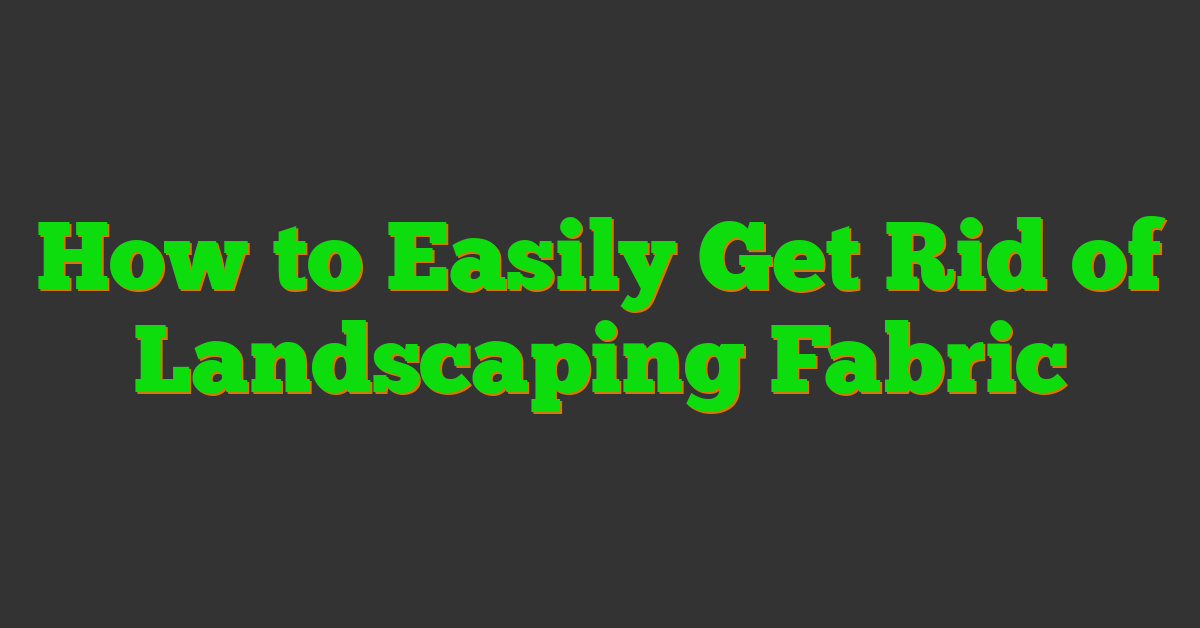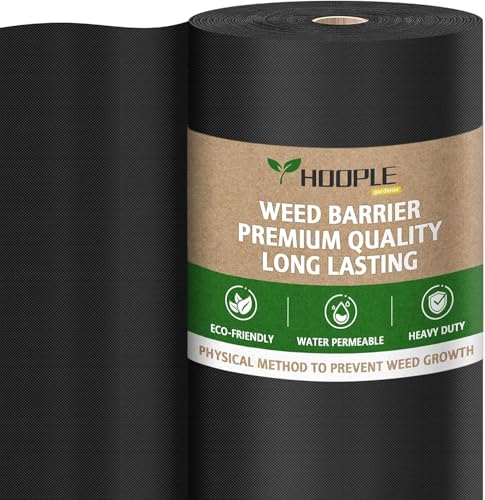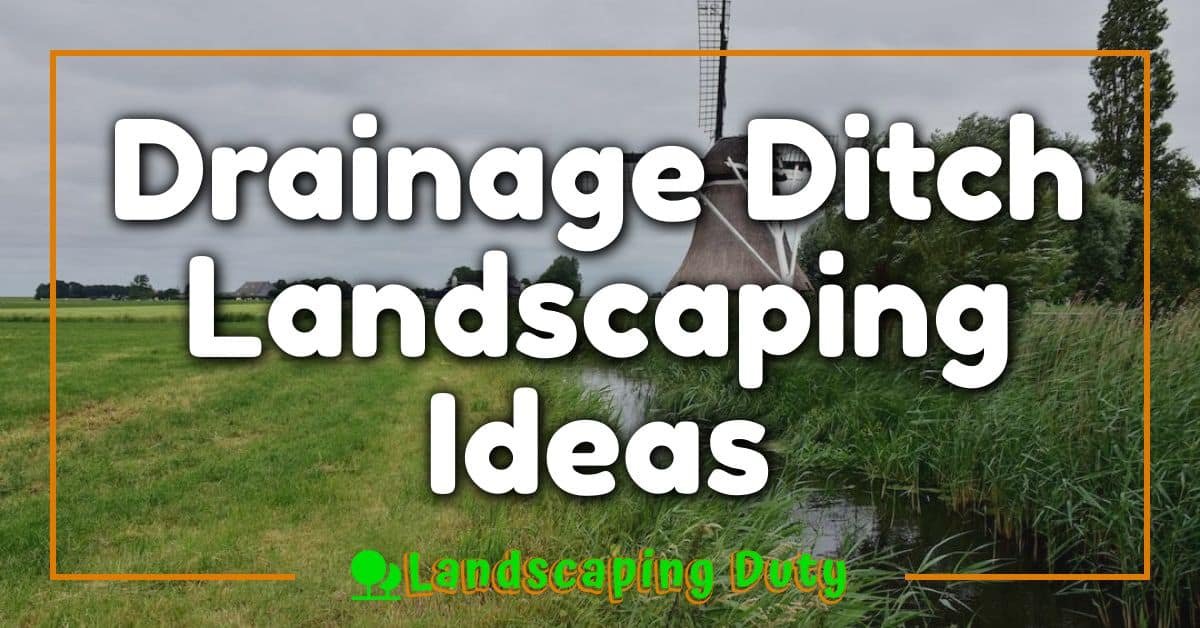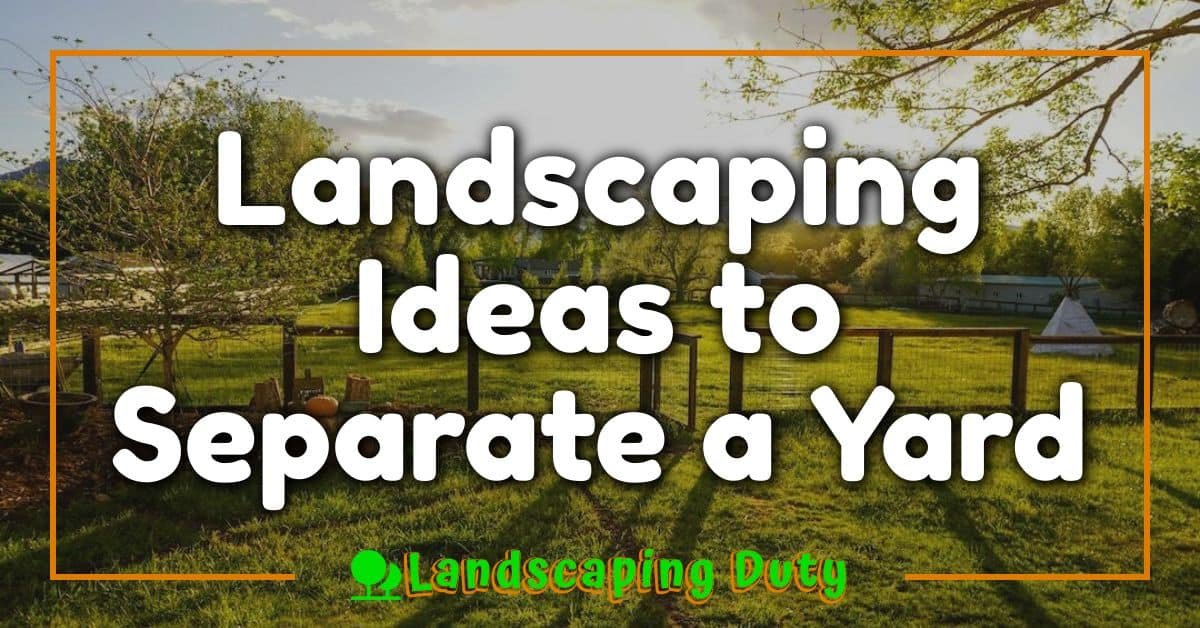If you’ve ever worked with landscape fabric, you know that it can be a great way to keep weeds at bay and promote healthy plant growth. However, over time, the fabric can become worn and torn, and it may even start to hinder the growth of your plants. When that happens, it’s time to get rid of the landscape fabric and start fresh. In this article, you’ll learn how to remove landscape fabric and get your garden back to looking its best.

Before you start the process of removing landscape fabric, it’s important to understand what it is and how it works. Landscape fabric is a permeable material that is designed to keep weeds from growing in your garden. It is typically made from woven or non-woven materials and comes in a variety of thicknesses and strengths. While landscape fabric can be a great tool for gardeners, it’s important to remember that it is not a permanent solution. Over time, the fabric can become worn and torn, and it may even start to hinder the growth of your plants.
Now that you understand what landscape fabric is and how it works, it’s time to get started on removing it. The process of removing landscape fabric can be a bit time-consuming, but with the right tools and techniques, you can get it done quickly and efficiently. In the next section, we’ll go over the preparation you’ll need to do before you start removing the fabric.
Key Takeaways
- Landscape fabric is a permeable material designed to keep weeds from growing in your garden.
- Over time, the fabric can become worn and torn, and it may even start to hinder the growth of your plants.
- To remove landscape fabric, you’ll need to prepare the area, carefully cut and remove the fabric, and clean up any remaining debris.
Understanding Landscape Fabric


If you are planning to create a beautiful garden, you may be considering using landscape fabric. Landscape fabric, also known as weed block or landscape cloth, is a material that is used to prevent weeds from growing in your garden. In this section, we will discuss the different types of landscape fabric, their benefits and drawbacks, and proper installation techniques.
Types of Landscape Fabric
There are several types of landscape fabric available in the market, including polypropylene, linen, and polyester. Polypropylene is the most commonly used landscape fabric due to its durability and affordability. Linen is another popular option that is known for its ability to decompose over time. Polyester is a more expensive option that is known for its strength and resistance to UV rays.
Benefits and Drawbacks
Landscape fabric has several benefits, including weed prevention, moisture retention, and erosion control. It also helps to keep the soil warm, which is beneficial for plants that require warmer temperatures. However, landscape fabric also has some drawbacks. For example, it can be difficult to remove once it is installed, and it can also trap water and prevent air from reaching the soil.
Proper Installation Techniques
Proper installation of landscape fabric is essential for its effectiveness. Before installing the fabric, it is important to remove any weeds or debris from the area. The fabric should be laid flat and secured with landscape staples or pins. It should also be overlapped at the seams to prevent weeds from growing through the gaps.
When installing plants, it is important to cut a hole in the fabric to allow the plant to grow. The hole should be just large enough for the plant to fit through, and the edges should be secured with staples or pins. Finally, it is important to cover the fabric with mulch to prevent it from drying out and to improve its appearance.
In conclusion, landscape fabric can be a useful tool for preventing weeds and improving the health of your garden. By understanding the different types of fabric, their benefits and drawbacks, and proper installation techniques, you can make an informed decision about whether or not to use landscape fabric in your garden.
Preparation for Removal

Before you remove the landscape fabric, you need to prepare yourself with the necessary tools and materials. Here are some things you should consider before starting the removal process:
Clearing the Surface
The first step to removing landscape fabric is to clear the surface of any mulch or rocks that are covering it. Use a shovel or a garden hoe to carefully clear away the top layer of mulch or rocks that are covering the fabric. This will give you better access to the fabric and make it easier to remove.
Assessing the Fabric Condition
Once you have cleared the surface, assess the condition of the fabric. Look for any signs of weed growth or damage to the fabric. If the fabric is in good condition, you can proceed with the removal process. However, if the fabric is damaged or has been in place for a long time, it may be difficult to remove. In such cases, you may need to use a utility knife or a pair of scissors to cut through the fabric.
Before you start the removal process, make sure you have the necessary tools and materials. Here is a list of things you will need:
- Shovel or garden hoe
- Utility knife or pair of scissors
- Gloves
- Trash bags or a wheelbarrow for disposal
By following these steps, you can prepare yourself for the landscape fabric removal process.
The Removal Process
https://www.youtube.com/watch?v=xlUW-irBgaA&embed=true
When it comes to removing landscape fabric, there are several steps involved. Below are the three main steps you should follow to get rid of the fabric.
Lifting the Edges
The first step is to lift the edges of the fabric. You can use a garden fork or a hoe to lift the fabric gently. Be sure to lift it slowly and carefully to avoid damaging any plants that may be growing through it. If the fabric has wrinkles, smooth them out before lifting the edges.
Cutting and Rolling
Once you have lifted the edges of the fabric, you can start cutting it into manageable sections. You can use scissors or a utility knife to cut the fabric. Make sure to cut along the edges of the fabric, avoiding any plants or shrubs that may be growing through it. Once you have cut the fabric into sections, roll them up and dispose of them properly.
Handling Entangled Roots
If you encounter any entangled roots while removing the landscape fabric, use a bit more force to cut through them. You can use a pruning saw or loppers to cut through the roots. Be sure to wear gloves to protect your hands while handling the roots.
By following these steps, you can remove the landscape fabric from your garden quickly and efficiently. Remember to dispose of the fabric properly to avoid any environmental damage.
Post-Removal Cleanup

« Is Landscaping VAT Exempt on New Build? Explained Can Landscaping Costs Be Capitalized? Explained »
Now that you have successfully removed the old landscaping fabric from your garden, it’s time to clean up the area and restore the soil. In this section, we will discuss two important steps you need to take to ensure that your garden is healthy and ready for new plants.
Disposing of Old Fabric
The first step is to dispose of the old fabric properly. You should gather all the ripped bits and pieces of the old fabric and put them in a trash bag. Make sure to seal the bag tightly to prevent any loose pieces from escaping. You can then dispose of the bag in your regular trash or take it to your local landfill.
Soil Restoration
The second step is to restore the soil. When you remove the old fabric, you may notice that the soil underneath is compacted and lacks nutrients. To restore the soil, you should loosen it up with a garden fork or tiller. This will help to aerate the soil and make it easier for roots to grow.
After loosening the soil, you can add compost or other organic matter to improve its nutrient content. Compost is a great option because it contains a variety of nutrients that plants need to grow. You can either make your own compost or purchase it from a garden center.
Once you have added compost, you should mix it thoroughly with the soil. You can use a rake or hoe to do this. Make sure that the compost is evenly distributed throughout the soil.
In conclusion, removing old landscaping fabric can be a messy and time-consuming process, but it’s worth it in the end. By properly disposing of the old fabric and restoring the soil, you can create a healthy and thriving garden that will provide you with fresh produce and beautiful flowers for years to come.
Alternatives to Landscape Fabric
https://www.youtube.com/watch?v=RhVcQ-uup-0&embed=true
If you’re looking for an alternative to landscape fabric, you’re in luck. There are several organic and inorganic mulching options that are eco-friendly, biodegradable, and effective at weed control.
Organic Mulching Options
Organic mulch is a great alternative to landscape fabric. It’s made from natural materials, such as wood chips, pine needles, and newspaper. Organic mulch helps to retain moisture in the soil, regulate soil temperature, and provide nutrients to your plants. Plus, it’s biodegradable, so it won’t harm the environment.
Wood chips and pine needles are both excellent options for organic mulch. They’re readily available and easy to install. Wood chips are great for pathways and garden beds, while pine needles are perfect for acid-loving plants like blueberries and azaleas.
Newspaper and cardboard are also great options for organic mulch. They’re both biodegradable and can be easily laid down in your garden beds. Simply lay down a layer of newspaper or cardboard, wet it down, and cover it with a layer of wood chips or pine needles.
Inorganic Mulching Techniques
Inorganic mulch is another alternative to landscape fabric. It’s made from materials like gravel, rocks, and rubber. Inorganic mulch helps to control weeds and retain moisture in the soil. Plus, it’s long-lasting and doesn’t need to be replaced as often as organic mulch.
Gravel and rocks are popular options for inorganic mulch. They’re available in a variety of colors and sizes, so you can choose the one that best suits your garden. Plus, they’re long-lasting and won’t break down over time.
Rubber mulch is another option for inorganic mulch. It’s made from recycled tires and is available in a variety of colors. Rubber mulch is long-lasting and won’t break down over time. Plus, it helps to control weeds and retain moisture in the soil.
Eco-Friendly Weed Control
Pre-emergent herbicides are an eco-friendly way to control weeds in your garden. They work by preventing weed seeds from germinating. Pre-emergent herbicides are safe for your plants and won’t harm the environment.
Biodegradable mulch is another eco-friendly way to control weeds in your garden. It’s made from natural materials like cornstarch and is biodegradable, so it won’t harm the environment. Plus, it helps to retain moisture in the soil and provides nutrients to your plants.
In conclusion, there are plenty of alternatives to landscape fabric that are eco-friendly, biodegradable, and effective at weed control. Whether you choose organic or inorganic mulch, or opt for pre-emergent herbicides or biodegradable mulch, you can rest assured that you’re making a choice that’s good for your garden and the environment.
Maintaining a Healthy Garden

To maintain a healthy garden, you need to focus on a few key things: fertilization, watering, and encouraging beneficial insects and microbes. These three elements work together to create a thriving ecosystem in your garden.
Fertilization and Watering
Fertilization and watering are essential to maintaining a healthy garden. Plants need essential nutrients to grow, and fertilizers provide those nutrients. Organic matter, such as compost and manure, can also provide essential nutrients to your plants.
When it comes to watering, it’s important to make sure your plants are getting enough water, but not too much. Overwatering can lead to root rot and other issues. On the other hand, underwatering can cause your plants to wilt and die.
Rainwater is an excellent source of water for your garden. It’s free, and it’s packed with essential nutrients that your plants need. If you’re not getting enough rain, you can use a watering can or hose to water your plants. Just make sure you’re not overwatering them.
Encouraging Beneficial Insects and Microbes
Beneficial insects and microbes are essential to maintaining a healthy garden. Earthworms, for example, help to aerate the soil and break down organic matter. Microbes, such as bacteria and fungi, help to break down organic matter and release essential nutrients into the soil.
To encourage beneficial insects and microbes, you can add compost and other organic matter to your garden. You can also use organic fertilizers, such as bone meal and blood meal, to provide essential nutrients to your plants.
Overall, maintaining a healthy garden requires a little bit of effort, but the rewards are well worth it. By fertilizing and watering your plants properly and encouraging beneficial insects and microbes, you can create a thriving ecosystem in your garden that will provide you with fresh, healthy produce for years to come.
Frequently Asked Questions

What are some eco-friendly alternatives to using landscape fabric?
If you are looking for eco-friendly alternatives to landscape fabric, consider using organic mulch, such as wood chips, straw, or leaves. These materials can help suppress weed growth and improve soil health without the use of chemicals. You can also use ground cover plants, such as creeping thyme or clover, to provide natural weed control.
How can you effectively remove old landscape fabric from your garden?
Removing old landscape fabric can be a tedious and time-consuming task, but it is necessary to ensure healthy plant growth. To remove landscape fabric, start by cutting it into manageable sections using a sharp pair of scissors or a utility knife. Then, carefully pull up the fabric, making sure to remove any staples or stakes that may be holding it in place. Finally, dispose of the fabric properly, either by composting it or placing it in the trash.
Is it possible to layer new landscape fabric over an existing one, and how?
While it is possible to layer new landscape fabric over an existing one, it is not recommended. The layers can trap moisture and prevent proper drainage, leading to waterlogged soil and root rot. If you need to replace your landscape fabric, it is best to remove the old fabric completely before laying down the new one.
What are the best practices for planting with landscape fabric?
When planting with landscape fabric, it is important to cut holes in the fabric to allow for proper plant growth. Make sure the holes are large enough to accommodate the plant’s root ball, but not so large that weeds can grow through. Also, be sure to water the plants regularly, as landscape fabric can prevent water from reaching the soil.
How can you manage weeds without relying on landscape fabric?
There are many ways to manage weeds without relying on landscape fabric. Consider using organic mulch, such as wood chips or straw, to suppress weed growth. You can also manually pull weeds or use a hoe to remove them. Additionally, planting ground cover plants or using a natural weed killer can help keep weeds at bay.
What are the long-term effects of landscape fabric on soil health?
While landscape fabric can help suppress weed growth and retain soil moisture, it can also have long-term negative effects on soil health. Landscape fabric can inhibit soil quality by preventing beneficial mulch and organic matter from mixing with the soil. It can also make it harder for worms and microorganisms to improve the soil. Over time, landscape fabric can lead to compacted soil and nutrient deficiencies.
















